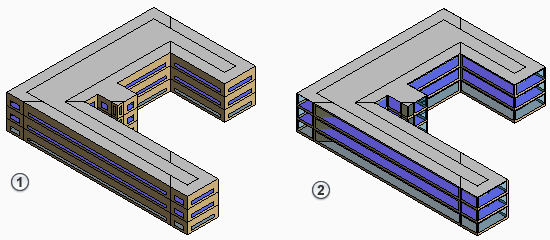When designing a sustainable building, consider the window area of the project carefully.
The glazing area must balance heat gain, heat loss, and potential glare problems with the need for natural light and an outside view. Most heating and cooling energy is transmitted in and out of a building through its windows. With intelligent design and careful selection of components, windows can be used to provide a comfortable and energy-efficient indoor environment.
Lighting is often the largest use in a non-residential building. The design goal should be a building that uses daylighting with electric lighting as a backup.
In a sunny climate, a 3 square-foot (0.3 square meter) perfectly clear opening (100% visible transmittance) will provide 40-50 footcandles of daylight in a space the size of a typical office. This is the ideal amount of light for an office. If the glass has a visible transmittance of 50%, you need twice as much glass to achieve the same amount of light.
When performing energy analysis, you can use the following parameters in the Advanced Energy Settings dialog to control glazing on the building facade: Target Percentage Glazing, Target Sill Height.
In the following examples,
 shows a model that uses a Target Percentage Glazing value of 20%, and
shows a model that uses a Target Percentage Glazing value of 20%, and
 shows the same model with a Target Percentage Glazing value of 70%.
shows the same model with a Target Percentage Glazing value of 70%.

Natural light and heat flow through a window can be controlled to some extent through appropriate size, window characteristics (Solar Heat Gain Coefficient (SHGC), U-value, and visible light transmittance), and solar orientation. Larger windows have more potential to lose or gain heat than smaller windows. South-facing windows (in the Northern hemisphere, and north-facing windows in the Southern hemisphere) transmit more heat and light than windows on the other orientations.
Overhangs and light shelves on south-facing windows can be designed to allow sunlight in winter and provide shade in the summer. However, it is difficult to control direct sunlight on the east and west facades, due to the lower sun angles.
Residential projects can take advantage of passive solar heating, but commercial projects typically make little use of this method. For non-residential projects, you need to be more concerned with controlling unwanted solar gain through the windows and providing daylight for interior spaces.
As a general rule, the daylighting zone is considered to be a depth of about twice the window head height (the distance from the floor to the top of the window). For example, if a space has windows with a head height of 6 feet, it may be feasible to daylight up to 12 feet deep into the space, assuming no internal partitions block the light.